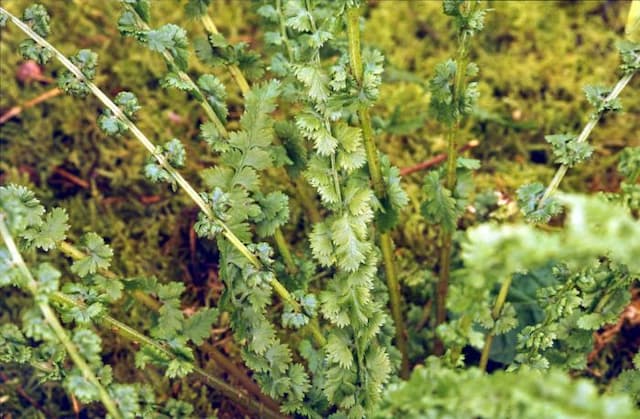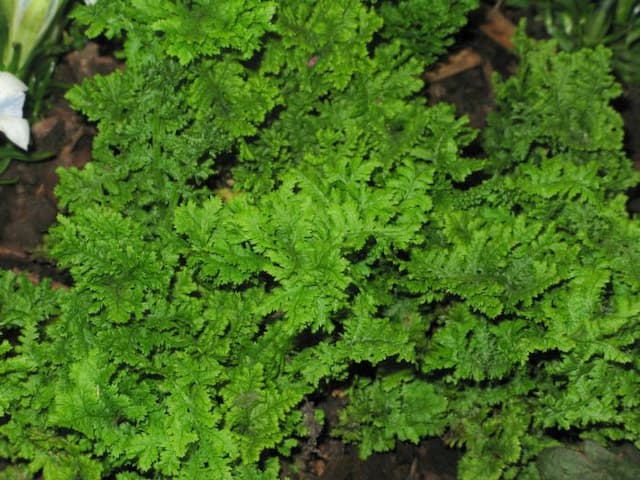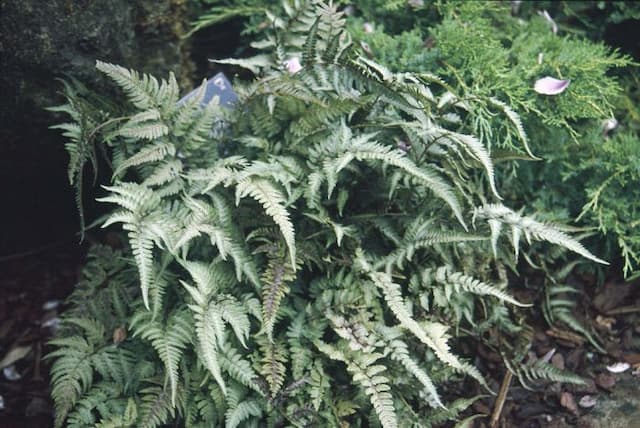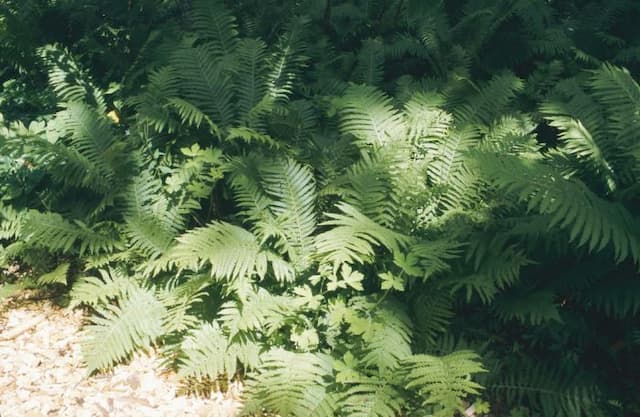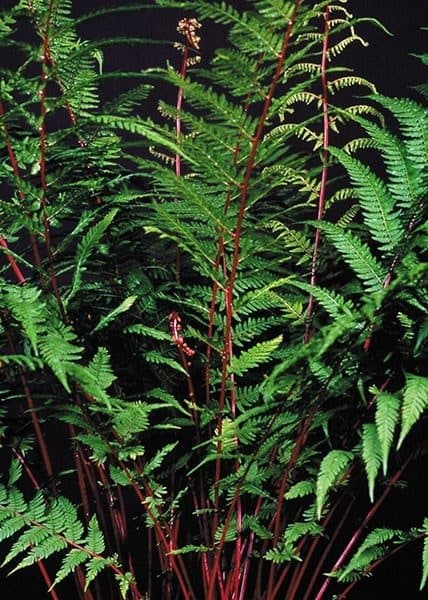Japanese Painted Fern Athyrium niponicum var. pictum 'Regal Red'

ABOUT
The 'Regal Red' is a variant of the Japanese Painted Fern that is primarily known for its captivating foliage. The fern displays a beautiful array of colors in its leaves. Each frond has a deep, rich burgundy hue that gently transitions into silver and green tones. These intricate fronds are comprised of delicate, feather-like leaves that gracefully arch and overlap, creating a dense layer of foliage with a striking textural appearance. The combination of reds, silvers, and greens gives the 'Regal Red' a regal and elegant look, living up to its name. This lush colorful display is particularly stunning when the fern is given enough shade to protect the vibrancy of its leaves. The 'Regal Red' can serve as a wonderful accent plant in any shade garden or woodland setting, adding a touch of sophistication and visual interest with its unique coloration.
About this plant
 Names
NamesFamily
Athyriaceae
Synonyms
Japanese Painted Fern, Regal Red Japanese Painted Fern
Common names
Athyrium niponicum 'Pictum', Athyrium goeringianum 'Pictum', Athyrium nipponicum 'Ursula's Red'.
 Toxicity
ToxicityTo humans
The Japanese Painted Fern is generally considered non-toxic to humans. There is no significant evidence suggesting that accidental ingestion would result in symptoms of poisoning. As with any non-food plant, individual sensitivities or allergic reactions can occur, so it's always a good practice to avoid ingesting plants not specifically grown for consumption.
To pets
The Japanese Painted Fern is also considered non-toxic to pets. It does not contain known toxins that would harm dogs, cats, or other household pets. Therefore, ingesting this plant should not cause poisoning. However, it's important to note that consumption of non-food plants can sometimes lead to gastrointestinal upset in pets, so it’s wise to keep an eye on your pet and discourage them from chewing on any plants.
 Characteristics
CharacteristicsLife cycle
Perennials
Foliage type
Deciduous
Color of leaves
Mixed
Height
1-2 feet (30-60 cm)
Spread
1-2 feet (30-60 cm)
Plant type
Fern
Hardiness zones
4-9
Native area
Japan
Benefits
 General Benefits
General Benefits- Ornamental Appeal: 'Regal Red' displays colorful foliage that adds visual interest to gardens and landscapes.
- Shade Tolerance: Thrives in shady areas where other plants may struggle, expanding the planting options in the garden.
- Low Maintenance: Requires minimal upkeep once established, making it ideal for gardeners of all skill levels.
- Drought Resistance: Once established, it can tolerate periods of low water, reducing the need for frequent irrigation.
- Cold Hardy: Able to survive in cooler climates, expanding its growing range to northern gardens.
- Erosion Control: The root system can help stabilize soil and prevent erosion on slopes or in problematic areas.
- Wildlife Habitat: Attracts butterflies and provides shelter for small creatures, enhancing biodiversity in the garden.
 Medical Properties
Medical PropertiesThis plant is not used for medical purposes.
 Air-purifying Qualities
Air-purifying QualitiesThis plant is not specifically known for air purifying qualities.
 Other Uses
Other Uses- Athyrium niponicum var. pictum 'Regal Red', commonly known as Japanese Painted Fern, can be used for art and craft projects because of its uniquely colored fronds, providing a natural and interesting material for eco-printing on fabrics or paper.
- The fronds of the Japanese Painted Fern can be incorporated into floral arrangements to add texture and color contrast, especially in woodland-themed bouquets or as a more lasting alternative to flowers in dried arrangements.
- Japanese Painted Fern can be a thematic element in fantasy or woodland-themed weddings, used in decorations, boutonnieres, and corsages for a natural, whimsical touch.
- The plant can be used in terrariums, particularly in larger ones where its smaller size and tolerance for humidity create a lush, miniaturized forest under glass.
- With its attractive foliage, the fern can be a natural dye source for textiles, yielding subtle shades of green and yellow, depending on mordants used.
- Japanese Painted Fern can act as a living mulch in the garden, its dense, spreading fronds helping to keep soil moist and reduce weed growth when planted in close proximity to other plants.
- The fern can serve educational purposes, such as in botany studies, illustrating the concepts of variegation and frond structure in ferns for students.
- Its uniquely colored fronds can be used in nature-inspired design or fashion, for example, as inspiration for color palettes in interior design or as a motif in print designs.
- Gardeners can employ the fern as a marker of seasonal changes, as its fronds often display color changes as temperatures fluctuate.
- Japanese Painted Fern can be utilized in photography, especially macro photography, as a subject to highlight natural patterns and color variations in the plant world.
Interesting Facts
 Feng Shui
Feng ShuiThe Japanese Painted Fern is not used in Feng Shui practice.
 Zodiac Sign Compitability
Zodiac Sign CompitabilityThe Japanese Painted Fern is not used in astrology practice.
 Plant Symbolism
Plant Symbolism- Delicacy and Grace: The fine texture and intricate patterns of the 'Regal Red' Japanese Painted Fern (Athyrium niponicum var. pictum 'Regal Red') symbolize a delicate beauty and an appreciation for the smaller details in life, reminding us of nature's gracefulness.
- Serenity and Tranquility: Often found in shaded and woodland gardens, the fern brings a sense of calm and peace, indicative of a serene environment where one can retreat for quiet and contemplation.
- Eternal Youth: Ferns, in general, are symbols of eternal youth and rejuvenation, due to their green color throughout the season and their long lifespan as a species.
- Secret Bond of Love: In the language of plants, ferns often represent a secret bond of love, making the 'Regal Red' fern a subtle nod to hidden or unspoken affection between individuals.
 Water
WaterJapanese painted fern should be watered regularly to keep the soil consistently moist but not waterlogged. During the growing season, provide the plant with approximately one gallon of water per week, depending on climate conditions and the plant's environment. If the weather is exceptionally hot or dry, or the fern is in a container and drying out faster, you may need to water it more frequently. In winter, reduce watering to match the plant's reduced growth and need for moisture. It is best to water directly at the base, avoiding getting water on the fronds to prevent disease.
 Light
LightJapanese painted fern thrives in partial to full shade. It is best positioned in a location where it can receive dappled sunlight or light shade throughout the day. Direct afternoon sunlight should generally be avoided to prevent scorching of the delicate fronds. An ideal spot would thus be under the canopy of larger plants or trees or on the shaded side of a building.
 Temperature
TemperatureJapanese painted fern prefers a temperature range between 60 to 70 degrees Fahrenheit for optimal growth, but it can tolerate temperatures as low as 50 degrees Fahrenheit. It should be protected from extreme cold, as temperatures below 20 degrees Fahrenheit might cause damage to the plant. This fern is suited to USDA hardiness zones 5 through 8, where it will naturally match its ideal temperature range throughout the growing season.
 Pruning
PruningPruning Japanese painted fern is not extensively necessary, but it can be done to remove dead or damaged fronds to maintain a tidy appearance and encourage healthy growth. The best time for pruning is in the spring when the new growth begins to emerge. It is seldom necessary to prune more than once a year, unless you are removing the occasional damaged leaf.
 Cleaning
CleaningAs needed
 Soil
SoilJapanese Painted Fern 'Regal Red' thrives in a soil mix that is rich in organic matter, well-draining, and kept consistently moist. A mix of one part garden soil, one part peat moss or coconut coir, and one part perlite or vermiculite is ideal. Aim for a soil pH between 5.5 and 6.5 to provide the best growing conditions.
 Repotting
RepottingJapanese Painted Fern 'Regal Red' should be repotted every 2-3 years to refresh the soil and accommodate its growing root system. It's best to repot in spring before the new fronds unfurl, minimizing stress on the plant.
 Humidity & Misting
Humidity & MistingJapanese Painted Fern 'Regal Red' prefers high humidity levels, ideally between 60-80%. Regular misting or placing the plant in a naturally humid environment like a bathroom can help maintain these conditions without addressing watering needs.
 Suitable locations
Suitable locationsIndoor
Keep in a shaded spot, high humidity, and moist soil.
Outdoor
Plant in shade, use moist, rich soil, and protect from wind.
Hardiness zone
4-9 USDA
 Life cycle
Life cycleAthyrium niponicum var. pictum 'Regal Red', more commonly known as Japanese Painted Fern 'Regal Red', begins its life cycle when spores, located on the undersides of mature frond segments, are released into the environment. The spores germinate and grow into a small, heart-shaped gametophyte, which is the sexual phase that produces both sperm and eggs. Fertilization occurs when water allows the sperm to swim to the eggs, forming a zygote that grows into a young fern, or sporophyte. The sporophyte matures and develops the characteristic textured and colored fronds of 'Regal Red', often unfurling these in spring. Throughout the growing season, the fern thrives in partial to full shade, expanding through rhizomes and may produce multiple fronds, with the reddest coloration appearing in cooler temperatures. As it enters dormancy during autumn or winter depending on climate, the fronds will die back, only to regrow the following spring, completing its perennial lifecycle.
 Propogation
PropogationPropogation time
Spring to summer
The Japanese painted fern 'Regal Red', is best propagated through division, which should ideally be carried out in the spring as the plant emerges from dormancy. This method involves carefully digging up the fern, ensuring a section of the root system and fronds are intact. Each division should have at least one growing point, often referred to as a crown, with attached roots and fronds. With a sharp knife or spade, the clump is divided into smaller clumps, each containing healthy roots and at least a few fronds. These divisions can then be replanted at the same depth they were originally growing, spaced approximately 18 inches (around 45 centimeters) apart to allow for spreading. After replanting, it is crucial to water them thoroughly to help establish the new plants.
